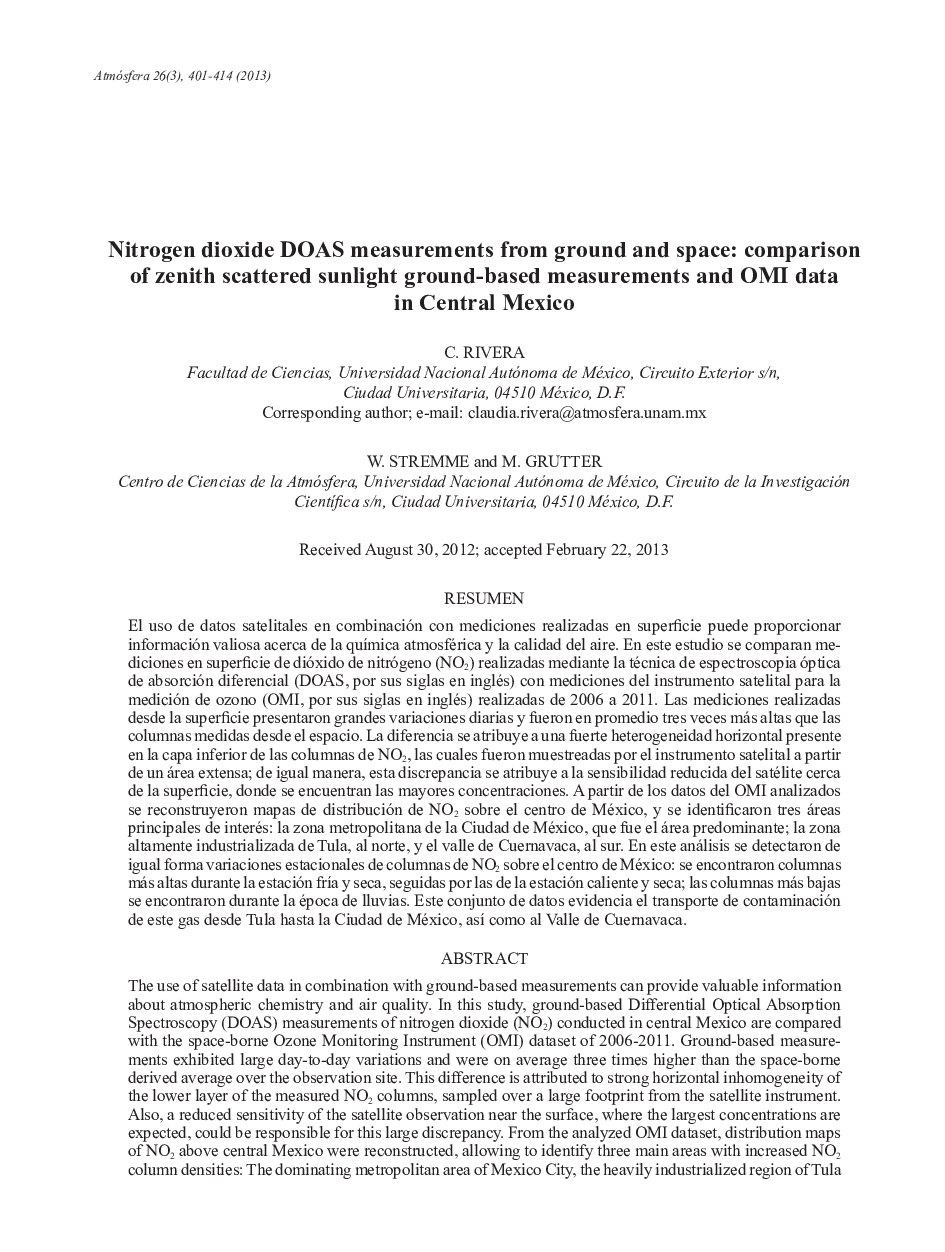| کد مقاله | کد نشریه | سال انتشار | مقاله انگلیسی | نسخه تمام متن |
|---|---|---|---|---|
| 4462058 | 1313458 | 2013 | 14 صفحه PDF | دانلود رایگان |

ResumenEl uso de datos satelitales en combinación con mediciones realizadas en superficie puede proporcionar información valiosa acerca de la química atmosférica y la calidad del aire. En este estudio se comparan mediciones en superficie de dióxido de nitrógeno (NO2) realizadas mediante la técnica de espectroscopia óptica de absorción diferencial (DOAS, por sus siglas en inglés) con mediciones del instrumento satelital para la medición de ozono (OMI, por sus siglas en inglés) realizadas de 2006 a 2011. Las mediciones realizadas desde la superficie presentaron grandes variaciones diarias y fueron en promedio tres veces más altas que las columnas medidas desde el espacio. La diferencia se atribuye a una fuerte heterogeneidad horizontal presente en la capa inferior de las columnas de NO2, las cuales fueron muestreadas por el instrumento satelital a partir de un área extensa; de igual manera, esta discrepancia se atribuye a la sensibilidad reducida del satélite cerca de la superficie, donde se encuentran las mayores concentraciones. A partir de los datos del OMI analizados se reconstruyeron mapas de distribución de NO2 sobre el centro de México, y se identificaron tres áreas principales de interés: la zona metropolitana de la Ciudad de México, que fue el área predominante; la zona altamente industrializada de Tula, al norte, y el valle de Cuernavaca, al sur. En este análisis se detectaron de igual forma variaciones estacionales de columnas de NO2 sobre el centro de México: se encontraron columnas más altas durante la estación fría y seca, seguidas por las de la estación caliente y seca; las columnas más bajas se encontraron durante la época de lluvias. Este conjunto de datos evidencia el transporte de contaminación de este gas desde Tula hasta la Ciudad de México, así como al Valle de Cuernavaca.
The use of satellite data in combination with ground-based measurements can provide valuable information about atmospheric chemistry and air quality. In this study, ground-based Differential Optical Absorption Spectroscopy (DOAS) measurements of nitrogen dioxide (NO2) conducted in central Mexico are compared with the space-borne Ozone Monitoring Instrument (OMI) dataset of 2006-2011. Ground-based measurements exhibited large day-to-day variations and were on average three times higher than the space-borne derived average over the observation site. This difference is attributed to strong horizontal inhomogeneity of the lower layer of the measured NO2 columns, sampled over a large footprint from the satellite instrument. Also, a reduced sensitivity of the satellite observation near the surface, where the largest concentrations are expected, could be responsible for this large discrepancy. From the analyzed OMI dataset, distribution maps of NO2 above central Mexico were reconstructed, allowing to identify three main areas with increased NO2 column densities: The dominating metropolitan area of Mexico City, the heavily industrialized region of Tula to the north and the Cuernavaca valley to the south. In this analysis, seasonal variability of NO2 columns over central Mexico was detected, finding higher NO2 columns during the dry and cold season, followed by the dry and warm period, and finally the lowest NO2 columns were found during the rainy season. Pollution transport of this gas from Tula into Mexico City, as well as towards the Cuernavaca valley, is evident from this dataset.
Journal: Atmósfera - Volume 26, Issue 3, July 2013, Pages 401–414